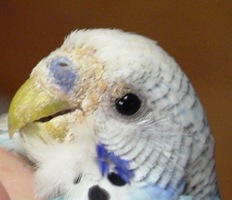In the case of a scaly beak, the crustiness can spread around the budgie's cere and eyes. The crusty, scaly appearance also appears on the legs and sometimes around the vent.
Untreated and sometimes even treated birds may develop permanent disfigurement in the case of a scaly beak and lameness in the case of scaly legs and feet. Serious complications usually occur that are not only extremely painful for the affected bird but often result in its death! This is a serious problem and you CAN'T leave it untreated!
 |
| Image © azeah.com |
Scaly leg mites bore under the scales on the legs, grow bigger and infect your bird as quickly as they got there. Same story for the scaly face mites: they burrow in the skin, causing a powdery appearance. The beak may look white, chalky and crusty and will have a honeycomb appearance. The mites spend their entire life cycle on the bird, so you can't just get rid of them. The problem is that the mites eventually will be transmitted from bird to bird through prolonged close contact. Some experts say that the mites will cause an extra disease if the bird is genetically susceptible, stressed, or has a suppressed immune system.
Diagnosis
Different species of mites affect different species of birds. Knemidokoptes mutans (scaly leg mites) and Knemidokoptes pilae (scaly face mites/burrowing mites) are most frequently found in budgies.
The problem is that the infection remains latent for a long time so that your budgie may appear normal for most of the time. If you suspect that your budgie is suffering from parasital mites, you should be able to detect it by looking for scaly gray or white crusty lesions on the nonfeathered skin. Some kinds of mites cause severe itching and even feather loss.
 |
| The feet of a healthy budgie should be free of any encrustation or malformation. Image © The Budgie Cage |
Most of the parasite mites are transmitted mainly in the nest box during feeding; i.e. during direct body contact from parents unto the chicks. Special attention should also be paid to couples, because they are in close contact with each other. A mite infestation in a budgie occurs between its 6th and 12th month of life; thus often shortly after the bird has been bought. So it's something you have to watch out for from the very beginning.



























